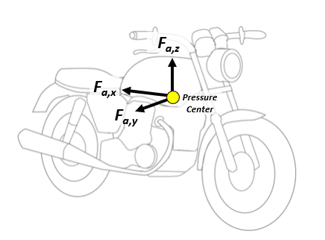Aerodynamics for Two-Wheelers
The resultant aerodynamic forces in the Two-wheeler implementation is considered to act on the pressure center point, usually located above the center of gravity of the motorcycles.
 Figure 1.
Figure 1. The aerodynamic forces are applied to the vehicle body are as follows:
Drag force represented as Fa,x: Fa,x = 0.5*Cx(τL)* ρ * A* vr2
Lateral force represented as Fa,y: Fa,y = 0.5*Cy(τL)* ρ * A* vr2
Lift force represented as Fa,z: Fa,z = 0.5*Cz,(τL)* ρ * A* vr2
Where Ci express the aerodynamic coefficients, τL the relative airflow incidence angle, vr the resulting velocity, ρ air density, and A frontal area.
Resulting Velocity and Dynamic Pressure
A diagonal airflow results in a flow velocity vr with an incidence angle τL to the vehicle’s longitudinal axis. Both parameters vr and τL can be calculated by vector addition of the road speed vector v and the wind velocity vector vw.
The dynamic pressure can be calculated using the air density ρ, the resulting velocity vr, using the following formula.
P(vr) = 0.5 * ρ * vr2
The air density is dependent on the ambient temperature and pressure of the environment and the ideal gas constant for air and it is often regarded as constant.
Aerodynamic Coefficients and Area
Reference by Vittore Cossalter 2, the product of drag coefficients and area Cx*A can vary from 0.18 to 0.7m2. The frontal area A reference value vary from 0.6 to 0.9m2 for large displacement touring motorcycles, 0.4 to 0.6m2 for sporting models, and 0.4 to 0.5m2 for grand prix motorcycle. The product of the lift coefficient and area Cz*A can vary from 0.06 to 0.12 m2.